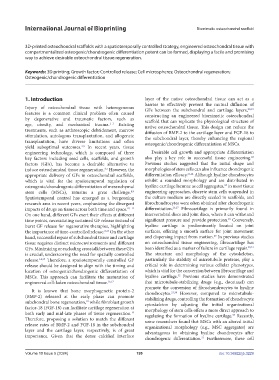Page 207 - IJB-10-5
P. 207
International Journal of Bioprinting Biomimetic osteochondral scaffold
3D-printed osteochondral scaffolds with a spatiotemporally controlled strategy, engineered osteochondral tissue with
compartmentalized osteogenic/chondrogenic differentiation potent can be formed, displaying a facile and promising
way to achieve desirable osteochondral tissue regeneration.
Keywords: 3D printing; Growth factor; Controlled release; Cell microspheres; Osteochondral regeneration;
Osteogenic/chondrogenic differentiation
1. Introduction layer of the native osteochondral tissue can act as a
barrier to effectively prevent the mutual diffusion of
Injury of osteochondral tissue with heterogeneous GFs between the subchondral and cartilage layers, 20,21
features is a common clinical problem often caused constructing an engineered biomimetic osteochondral
by degenerative and traumatic factors, such as scaffold that can replicate the physiological structure of
age, obesity, and mechanical trauma. Existing native osteochondral tissue. This design can reduce the
1–3
treatments, such as arthroscopic debridement, marrow diffusion of BMP-2 to the cartilage layer and FGF-18 to
stimulation, autologous transplantation, and allogeneic the subchondral layer, thereby enhancing the regional
transplantation, have diverse limitations and often osteogenic/chondrogenic differentiation of MSCs.
yield suboptimal outcomes. In recent years, tissue
4,5
engineering technology, which is composed of three Desirable cell growth and appropriate differentiation
22
key factors including seed cells, scaffolds, and growth also play a key role in successful tissue engineering.
factors (GFs), has become a desirable alternative to Previous studies suggested that the initial shape and
induce osteochondral tissue regeneration. However, the morphologies of stem cells can also influence chondrogenic
6,7
appropriate delivery of GFs in osteochondral scaffolds, differentiation efficacy. 23,24 Although hyaline chondrocytes
which is vital for the spatiotemporal regulation of exhibit a rounded morphology and are distributed in
25
osteogenic/chondrogenic differentiation of mesenchymal hyaline cartilage lacunae as cell aggregates, in most tissue
stem cells (MSCs), remains a great challenge. engineering approaches, discrete stem cells suspended in
8,9
Spatiotemporal control has emerged as a burgeoning the culture medium are directly seeded in scaffolds, and
research area in recent years, emphasizing the divergent fibrochondrocytes were often obtained after chondrogenic
impacts of drugs on tissue across both time and space. 10–12 differentiation. 26,27 Fibrocartilage is primarily found in
On one hand, different GFs exert their effects at different intervertebral discs and joint discs, where it can withstand
28
time points, necessitating sustained GF release instead of significant pressure and provide protection. Conversely,
burst GF release for regenerative therapies, highlighting hyaline cartilage is predominantly located on joint
the importance of time-controlled release. 8,13 On the other surfaces, offering a smooth surface for joint movement
29
hand, successful repair of subchondral tissue and cartilage and dispersing impact from motion. In previous studies
tissue requires distinct microenvironments and different on osteochondral tissue engineering, fibrocartilage has
GFs. Minimizing or excluding crosstalk between these GFs been identified as a marker of failure in cartilage repair. 30,31
is crucial, underscoring the need for spatially controlled The structure and morphology of the cytoskeleton,
release. 14,15 Therefore, a spatiotemporally controlled GF particularly the stability of microtubule proteins, play a
release should be designed to align with the timing and critical role in determining various cellular phenotypes,
location of osteogenic/chondrogenic differentiation of which is vital for the conversion between fibrocartilage and
32
MSCs. This approach can facilitate the maturation of hyaline cartilage. Previous studies have demonstrated
engineered cell-laden osteochondral tissue. 16,17 that microtubule-stabilizing drugs (e.g., docetaxel) can
promote the conversion of fibrochondrocytes to hyaline
It is known that bone morphogenetic protein-2 33,34
(BMP-2) released at the early phase can promote chondrocytes. However, compared to microtubule-
stabilizing drugs, controlling the formation of chondrocyte
subchondral bone regeneration, while fibroblast growth cytoskeleton by adjusting the initial organizational
18
factor-18 (FGF-18) can facilitate cartilage regeneration at morphology of stem cells offers a more direct approach to
both early and mid-late phases of tissue regeneration. regulating the formation of hyaline cartilage. Recently,
19
35
Therefore, proposing a solution to match the different some researchers found that MSCs with an altered initial
release rates of BMP-2 and FGF-18 in the subchondral organizational morphology (e.g., MSC aggregates) are
layer and the cartilage layer, respectively, is of great advantageous in obtaining hyaline chondrocytes after
importance. Given that the dense calcified interface
chondrogenic differentiation. Furthermore, these cell
23
Volume 10 Issue 5 (2024) 199 doi: 10.36922/ijb.3229

